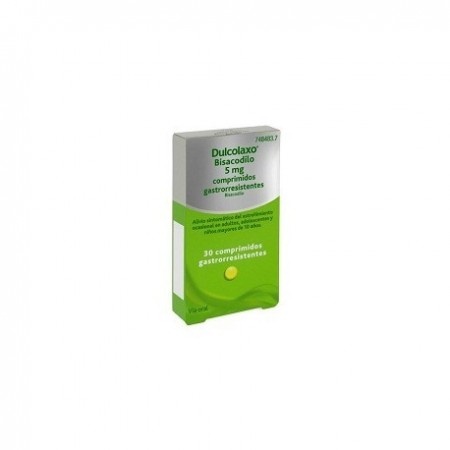

ДУЛКОЛАКС БИСАКОДИЛ 5 мг ТАБЛЕТКИ ЖЕЛУДОЧНО-КИШЕЧНО УСТОЙЧИВЫЕ

Спросите врача о рецепте на ДУЛКОЛАКС БИСАКОДИЛ 5 мг ТАБЛЕТКИ ЖЕЛУДОЧНО-КИШЕЧНО УСТОЙЧИВЫЕ

Инструкция по применению ДУЛКОЛАКС БИСАКОДИЛ 5 мг ТАБЛЕТКИ ЖЕЛУДОЧНО-КИШЕЧНО УСТОЙЧИВЫЕ
Введение
Инструкция: информация для пользователя
Дулколакс Бисакодил 5 мг гастрорезистентные таблетки
Бисакодил
Прочитайте внимательно всю инструкцию перед началом приема этого лекарства, поскольку она содержит важную информацию для вас.
Следуйте точно инструкциям по применению лекарства, изложенным в этой инструкции или указанным вашим врачом или фармацевтом.
- Сохраните эту инструкцию, поскольку вам может потребоваться прочитать ее снова.
- Если вам нужен совет или дополнительная информация, проконсультируйтесь с вашим фармацевтом.
- Если вы испытываете побочные эффекты, проконсультируйтесь с вашим врачом или фармацевтом, даже если это побочные эффекты, не указанные в этой инструкции. См. раздел 4
- Вы должны проконсультироваться с врачом, если ваше состояние ухудшается, если после приема максимальной суточной дозы не происходит дефекации в течение 12 часов, или если ваше состояние не улучшается после 7 дней лечения.
Содержание инструкции:
- Что такое Дулколакс и для чего он используется
- Что вам нужно знать перед началом приема Дулколакса
- Как принимать Дулколакс
- Возможные побочные эффекты
- Хранение Дулколакса
- Содержание упаковки и дополнительная информация
1. Что такое Дулколакс и для чего он используется
Бисакодил, активное вещество этого лекарства, относится к группе стимулирующих слабительных, которые действуют путем прямого контакта с слизистой оболочкой кишечника, стимулируя нервные окончания кишечной стенки, тем самым увеличивая ее моторику.
Он показан для симптоматического облегчения случайного запора у взрослых, подростков и детей старше 10 лет.
Вы должны проконсультироваться с врачом, если ваше состояние ухудшается или если оно не улучшается после 7 дней лечения.
2. Что вам нужно знать перед началом приема Дулколакса
Не принимайте Дулколакс:
- Если вы аллергичны к бисакодилу или любому другому компоненту этого лекарства (перечисленному в разделе 6).
- Если у вас есть боли в животе неизвестного происхождения.
- Если у вас есть кишечная непроходимость или паралитический илеус.
- Если у вас есть аппендицит или перфорация кишечника.
- Если у вас есть кровотечение из желудочно-кишечного тракта или воспалительные заболевания кишечника (язвенный колит, болезнь Крона).
- Если пациент моложе 2 лет.
- Если у вас есть нарушения водно-электролитного обмена.
Предостережения и меры предосторожности
- Это лекарство не должно приниматься непрерывно каждый день или в течение длительных периодов без исследования причины запора.
- Если вам больше 65 лет или если вы ослаблены, вы должны пить много жидкости и минеральных солей и сообщить вашему врачу, что вы используете слабительное, чтобы он мог контролировать уровень электролитов и избежать проблем с обезвоживанием. Симптомы обезвоживания включают сильную жажду и редкое мочеиспускание.
- Если во время приема этого лекарства вы заметите головокружение и/или обморок, это может быть связано с запором и не обязательно с приемом этого лекарства. Эти симптомы могут возникнуть в результате напряжения при дефекации или как реакция на боли в животе.
- Стимулирующие слабительные, включая Дулколакс, не помогают в снижении веса.
Проконсультируйтесь с вашим врачом или фармацевтом перед началом приема Дулколакса:
- Если у вас, кроме запора, есть симптомы аппендицита, такие как тошнота, рвота или боли в животе, рекомендуется обратиться к врачу для диагностики аппендицита.
- Если у вас хронический запор, поскольку в этом случае необходимо исследовать причину запора.
Дети и подростки
Дети от 2 до 10 лет могут принимать это лекарство только под медицинским контролем.
Дети моложе 2 лет не могут принимать это лекарство, оно противопоказано для них.
Прием Дулколакса с другими лекарствами
Сообщите вашему врачу или фармацевту, если вы принимаете, недавно принимали или можете принимать любое другое лекарство.
В частности, если вы принимаете одно из следующих лекарств, может потребоваться прекратить лечение или изменить дозу одного из них:
- Лекарства, используемые для лечения сердечного ритма: антиаритмические препараты (хинидин).
- Противовоспалительные лекарства (кортикостероиды).
- Лекарства, используемые для увеличения диуреза: тиазидные диуретики.
- Лекарства, используемые для лечения сердечных заболеваний: сердечные гликозиды, такие как дигоксин.
- Антиацидные и противоязвенные лекарства (ингибиторы протонной помпы, антагонисты гистамина H2), прием которых должен быть разделен как минимум на 2 часа.
- Лекарства на основе солодки.
- Другие слабительные
Взаимодействие с диагностическими тестами:
- При приеме этого лекарства могут повыситься уровни глюкозы в крови, поэтому диабетические пациенты должны учитывать это.
- Прием этого лекарства также может повлиять на результаты аналитических тестов, поскольку длительное использование слабительных может привести к снижению уровня калия в крови (гипокалиемии).
Прием Дулколакса с пищей и напитками
Не принимайте солодку во время приема этого лекарства.
Необходимо избегать одновременного приема Дулколакса с молоком или принимать их с интервалом не менее 2 часов, поскольку это может увеличить абсорбцию лекарства.
Беременность, лактация и фертильность
Если вы беременны или кормите грудью, предполагаете, что можете быть беременной или планируете беременность, проконсультируйтесь с вашим врачом или фармацевтом перед приемом этого лекарства.
Вождение и использование машин
Во время приема этого типа слабительных из-за вазовагальной реакции (например, спазмов в животе) вы можете испытывать головокружение и/или обморок. Если вы испытываете спазмы в животе, избегайте потенциально опасных задач, таких как вождение или работа с машинами.
Дулколакс содержит сахарозу, лактозу и касторовое масло
Это лекарство содержит сахарозу и лактозу. Если ваш врач указал, что у вас есть непереносимость определенных сахаров, проконсультируйтесь с ним перед приемом этого лекарства.
Это лекарство может вызывать желудочные расстройства и диарею, поскольку содержит касторовое масло.
3. Как принимать Дулколакс
Следуйте точно инструкциям по применению этого лекарства, изложенным в этой инструкции или указанным вашим врачом или фармацевтом. В случае сомнений проконсультируйтесь с вашим врачом или фармацевтом снова.
Рекомендуемая доза для взрослых составляет:
1 таблетка (5 мг бисакодила) в день перед сном. Если необходимо, принимайте 2 таблетки.
Используйте всегда минимальную эффективную дозу.
Использование у детей и подростков
Рекомендуемая доза для подростков и детей старше 10 лет составляет 1 таблетка (5 мг бисакодила) в день перед сном. Если необходимо, принимайте 2 таблетки.
Используйте всегда минимальную эффективную дозу.
Дети от 2 до 10 лет
Дети от 2 до 10 лет могут принимать это лекарство только под медицинским контролем.
1 таблетка (5 мг бисакодила) в день перед сном.
Дети моложе 2 лет
Дети моложе 2 лет не могут принимать это лекарство, оно противопоказано для них.
Как принимать:
Это лекарство принимается перорально.
Рекомендуется проглотить таблетку целиком, не разжевывая и с большим количеством жидкости, вечером или утром натощак. Если принимать вечером, дефекация обычно происходит примерно через 10 часов. Если принимать утром натощак, дефекация обычно происходит примерно через 6 часов.
Если симптомы ухудшаются, если после приема максимальной суточной дозы не происходит дефекации в течение 12 часов, или если симптомы сохраняются более 7 дней лечения, необходимо проконсультироваться с врачом.
Если вы приняли больше Дулколакса, чем должно быть
Если вы приняли больше Дулколакса, чем должно быть, немедленно проконсультируйтесь с вашим врачом или фармацевтом.
Наиболее частые симптомы передозировки включают боли в животе, рвоту, слизистые и диарейные испражнения, потерю жидкости, калия и других электролитов, усталость или слабость.
Лечение в этих случаях будет включать прекращение приема слабительного и последующую реабилитацию с помощью солевого раствора, жидкостей и введения минеральных солей. Эти меры особенно важны для пожилых людей и молодых.
В случае передозировки или случайного приема обратитесь к вашему врачу или позвоните в Токсикологическую информационную службу (телефон: 91 562 04 20), указав лекарство и количество, принятое внутрь.
4. Возможные побочные эффекты
Как и все лекарства, это лекарство может вызывать побочные эффекты, хотя не все люди испытывают их.
Во время периода использования лекарств с бисакодилом были обнаружены следующие побочные эффекты, частота которых не может быть точно установлена. Наиболее частые побочные эффекты включают боли в животе и диарею. Также могут возникнуть: дискомфорт в животе, анальные расстройства, нарушения пищеварения, такие как боли или спазмы в животе (которые могут сопровождаться тошнотой и/или рвотой), кровянистые испражнения (гематошея), метеоризм, вздутие живота, замедление кишечной моторики и колит. Реже также могут возникнуть аллергические реакции, кожные высыпания, обезвоживание и отек лица, губ, рта, языка или горла, который может вызвать затруднение глотания или дыхания (ангиоэдем).
Прием лекарств с бисакодилом, активным веществом этого лекарства, в течение длительного времени может привести к увеличению потери воды, калия и других солей. Это может привести к нарушениям сердечной функции, мышечной слабости и усталости, особенно если принимать их одновременно с диуретиками и кортикостероидами.
Кроме того, были зарегистрированы случаи головокружения и обморока. Головокружение и обморок, возникающие после приема лекарств с бисакодилом, могут быть связаны с вазовагальной реакцией (например, спазмом в животе, дефекацией).
Сообщение о побочных эффектах:
Если вы испытываете любой побочный эффект, проконсультируйтесь с вашим врачом или фармацевтом, даже если это возможные побочные эффекты, не указанные в этой инструкции. Также вы можете сообщить о них напрямую через Испанскую систему фармакологического надзора за лекарствами для человека: https://www.notificaram.es. Сообщая о побочных эффектах, вы можете внести свой вклад в предоставление более полной информации о безопасности этого лекарства.
5. Хранение Дулколакса
Храните это лекарство в недоступном для детей месте.
Не требует специальных условий хранения.
Срок годности
Не используйте это лекарство после срока годности, указанного на упаковке после CAD. Срок годности - последний день месяца, указанного.
Лекарства не должны выбрасываться в канализацию или мусор. Сдайте упаковку и лекарства, которые вам больше не нужны, в пункт SIGRE аптеки. Если у вас есть сомнения, проконсультируйтесь с вашим фармацевтом о том, как избавиться от упаковки и лекарств, которые вам больше не нужны. Таким образом, вы поможете защитить окружающую среду.
6. Содержание упаковки и дополнительная информация
Состав Дулколакса
- Активное вещество - бисакодил. Каждая гастрорезистентная таблетка содержит 5 мг бисакодила.
- Другие компоненты (вспомогательные вещества) - сахароза, лактоза, кукурузный крахмал, глицерин (E-422), стеарат магния, тальк, аравийская камедь, диоксид титана (E-171), сополимер метакриловой кислоты и метакрилата (1:1), сополимер метакриловой кислоты и метакрилата (1:2), касторовое масло, макрогол 6000, оксид железа желтый (E-172), белый воск, карнаубский воск и лак.
Внешний вид продукта и содержание упаковки
Дулколакс - круглые таблетки желтовато-коричневого цвета, гастрорезистентные (устойчивые к желудочному соку для действия в кишечнике).
Продаются в упаковках по 30 гастрорезистентных таблеток.
Владелец разрешения на маркетинг:
Opella Healthcare Spain, S.L.
C/ Rosselló i Porcel, 21
08016 – Барселона
Испания
Группа Sanofi
Производитель:
DELPHARM REIMS
10, Rue Colonel Charbonneaux
51100 Реймс – Франция
Дата последнего пересмотра этой инструкции:08/2019
Подробная и актуальная информация о этом лекарстве доступна на сайте Испанского агентства по лекарствам и медицинским изделиям (AEMPS) http://www.aemps.gob.es/
Дополнительная информация для пациента:
Дулколакс также доступен на рынке в следующих формах:
Свечи: Дулколакс бисакодил 10 мг свечи
Оральные капли: Дулколакс пикосульфат 7,5 мг/мл оральные капли
- Страна регистрации
- Активное вещество
- Требуется рецептНет
- Производитель
- Информация носит справочный характер и не является медицинской рекомендацией. Перед приемом любых препаратов проконсультируйтесь с врачом. Oladoctor не несет ответственности за медицинские решения, принятые на основе этого контента.
- Аналоги ДУЛКОЛАКС БИСАКОДИЛ 5 мг ТАБЛЕТКИ ЖЕЛУДОЧНО-КИШЕЧНО УСТОЙЧИВЫЕФорма выпуска: ТАБЛЕТКА, 5,00 мг бисакодила на таблеткуАктивное вещество: БисакодилПроизводитель: Roha Arzneimittel GmbhНе требуется рецептФорма выпуска: СУППОЗИТОРИЙ, 10 мг бисакодилаАктивное вещество: БисакодилПроизводитель: Opella Healthcare Spain S.L.Не требуется рецептФорма выпуска: ОРАЛЬНЫЙ РАСТВОР/СУСПЕНЗИЯ, 1г/млАктивное вещество: Касторовое маслоПроизводитель: Laboratorio Reig Jofre, S.A.Не требуется рецепт
Аналоги ДУЛКОЛАКС БИСАКОДИЛ 5 мг ТАБЛЕТКИ ЖЕЛУДОЧНО-КИШЕЧНО УСТОЙЧИВЫЕ в других странах
Лучшие аналоги с тем же действующим веществом и терапевтическим эффектом.
Аналог ДУЛКОЛАКС БИСАКОДИЛ 5 мг ТАБЛЕТКИ ЖЕЛУДОЧНО-КИШЕЧНО УСТОЙЧИВЫЕ в Польша
Аналог ДУЛКОЛАКС БИСАКОДИЛ 5 мг ТАБЛЕТКИ ЖЕЛУДОЧНО-КИШЕЧНО УСТОЙЧИВЫЕ в Украина
Врачи онлайн по ДУЛКОЛАКС БИСАКОДИЛ 5 мг ТАБЛЕТКИ ЖЕЛУДОЧНО-КИШЕЧНО УСТОЙЧИВЫЕ
Консультация по дозировке, побочным эффектам, взаимодействиям, противопоказаниям и продлению рецепта на ДУЛКОЛАКС БИСАКОДИЛ 5 мг ТАБЛЕТКИ ЖЕЛУДОЧНО-КИШЕЧНО УСТОЙЧИВЫЕ – по решению врача и с учетом местных правил.














